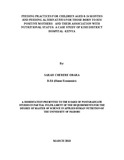| dc.description.abstract | Poor breastfeeding and infant feeding practices have adverse effects on the health and
nutritional status of children, HIV being one of the major confounding circumstances in
infant feeding. Against the backdrop of this realization, efforts are therefore required to
protect, promote and support appropriate infant feeding practices.
The study was designed to assess the infant feeding practices and feeding alternatives
available for children of the untested mothers and those born to HIV positive mothers,
and the factors determining choice of infant feeding alternatives. The Mother-to- child
transmission (MCTC) knowledge level of mothers and the general nutrition status of the
children were also assessed.*
The study was cross sectional and explanatory. It was carried out in Kisii District hospital
on a sample of 186 children aged 0-24 months with their respective mothers or caretakers
as respondents. A previously pre-tested and structured questionnaire was used to collect
data on: infant feeding practices; breast milk alternatives; MTCT knowledge of the
mothers; anthropometry of the children; socio-economic and demographic characteristics
of the households; morbidity; and nutritional status. In addition focus group discussions,
key informant interviews and observations were used as supplementary methods of data
collection.*
Simple descriptive statistics, bivariate analysis (chi-square test) and multivariate logistic
regression analysis were performed on the data using SPSS (version 12.01) and Epi Info
(version 6) software.*
In general there were significant differences in the infant feeding practices by the non
tested mothers from those of the HIV positive mothers. The main complementary foods
given were cow milk, uji, meat, pulses and eggs. The HIV positive mothers gave
significantly more meat, legumes and eggs than the non-tested mothers.*
On 19.5% of the children below the age of 2 months were exclusively breastfed. The
practice of giving pre-lacteal (cow milk and herbal concoctions was common.
Complementary foods mainly cow’s milk and uji were introduced early at a mean age of
2-3 months due to perceived milk insufficiency. Up to 85.4% of the children had been
breast fed. Slightly more than half of the mothers introduce breast milk within the first 24
hours of delivery. Breast feeding was mainly on demand and continued to the second
year (median 23 months) of life of the infant.*
There were significant differences p<0.05 between the level of use of the infant feeding
alternatives by the HIV positive mothers and by the non- tested mothers. The main
alternatives were wet nursing, breast milk, cow milk. Cow milk was the most popular
alternative and wet nursing was significantly more acceptable to the HIV positive
mothers than the non tested mothers. The HIV positive mothers had a higher MTCT
knowledge level than the non-tested mothers. The maternal MTCT knowledge was poor
at 19.6 among the non tested mothers and a bit higher among the HIV positive mothers at
39.4%. The choice of infant feeding alternative was influenced by a number of factors
including: cultural attitudes, health and nutrition education and knowledge on MTCT.*
Exclusive breastfeeding was significantly associated with nutritional status of the child in
regards to the underweight status of the child. Children who were not exclusively
breastfed had a higher likelihood of being underweight. Immunization status of the child
also had significant association with the nutritional status of the child.* Marital status of
the mother has significant association with wasting and underweight status. Age of the
index child also has a significant association with wasting and underweight status.*
The nutritional status of the children born to the non tested mothers indicated that: 9.9%
were severely stunted, 0.8% was severely wasted and 6% were severely underweight.
However the nutritional status of children born to the HIV positive mothers indicated that
46.4% were severely stunted, 28.6% were severely wasted, and 35.7% were severely
underweight.*
There were significant differences (P=<0.05) in the morbidity patterns of the children
born to HIV Positive mothers in comparison to the non-tested mothers. Anaemia and
pneumonia were significantly more prevalent among children born to HIV positive
mothers than among those born to the non tested mothers.*
The two main predictors of the nutritional status were age of the child, and exclusive
breastfeeding. The nutritional status of children born to HIV positive mothers was
significantly poorer than that of the children born to untested mothers.
The level of use of alternatives was significantly higher among the HIV positive mothers
than among the non tested ones. | en |

